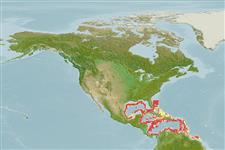Common names from other countries
Ελασμοβράγχιοι (καρχαρίες και σαλάχια) (sharks and rays) >
Carcharhiniformes (Ground sharks) >
Pentanchidae (Deepwater catsharks)
Etymology: Apristurus: a-, Latin privative, i.e., without; pristis, from pristes (Gr.), sawyer (but here meaning saw); oura (Gr.), tail, referring to absence of saw-toothed crest of enlarged dermal denticles along upper edge of caudal fin as found in the closely related Pristiurus (=Galeus). (See ETYFish); parvipinnis: parvus (L.), small; pinnis (L.), fin, referring to first dorsal fin 2-4 times smaller than second dorsal fin. (See ETYFish).
Environment: milieu / climate zone / depth range / distribution range
Οικολογία
Θαλασσινό(ά) βαθύβιο(ς); εύρος βάθους 600 - 1380 m (Ref. 44037). Deep-water; 30°N - 6°N
Western Atlantic: northeastern Gulf of Mexico off Florida, Gulf of Campeche, Panama, Colombia, and off French Guiana. Had been originally termed Apristurus indicus by Springer (1966) but apparently not conspecific with the Indian Ocean species.
Μέγεθος / Βάρος / Age
Maturity: Lm ? range ? - ? cm
Max length : 48.0 cm TL αρσενικό/απροσδιόριστο; (Ref. 244); 52.0 cm TL (female)
Second dorsal fin distinctly larger than the first (Ref. 13608).
Found on the continental slope. Oviparous, apparently laying one egg per oviduct at a time. The most common Apristurus species in the Gulf of Mexico, along with A. laurussonii.
Life cycle and mating behavior
Maturities | Αναπαραγωγή | Spawnings | Egg(s) | Fecundities | Προνύμφες
Oviparous, paired eggs are laid. Embryos feed solely on yolk (Ref. 50449).
Compagno, L.J.V., 1984. FAO Species Catalogue. Vol. 4. Sharks of the world. An annotated and illustrated catalogue of shark species known to date. Part 2 - Carcharhiniformes. FAO Fish. Synop. 125(4/2):251-655. Rome: FAO. (Ref. 244)
IUCN Red List Status (Ref. 130435)
CITES (Ref. 128078)
Not Evaluated
Threat to humans
Harmless
Human uses
αλιεία: παραδοσιακή αλιεία
Εργαλεία
Special reports
Download XML
Διαδικτυακές πηγές
Estimates based on models
Preferred temperature (Ref.
115969): 5.2 - 10.4, mean 6.4 (based on 83 cells).
Phylogenetic diversity index (Ref.
82804): PD
50 = 0.5000 [Uniqueness, from 0.5 = low to 2.0 = high].
Bayesian length-weight: a=0.00355 (0.00176 - 0.00714), b=3.09 (2.91 - 3.27), in cm Total Length, based on LWR estimates for this (Sub)family-body shape (Ref.
93245).
Τροφικό Επίπεδο (Ref.
69278): 3.9 ±0.4 se; based on size and trophs of closest relatives
Ελαστικότητα (Ref.
120179): Πολύ χαμηλό, ελάχιστος χρόνος για διπλασιασμό πληθυσμού > 14 έτη (Fec assumed to be <10).
Fishing Vulnerability (Ref.
59153): Moderate vulnerability (41 of 100).
